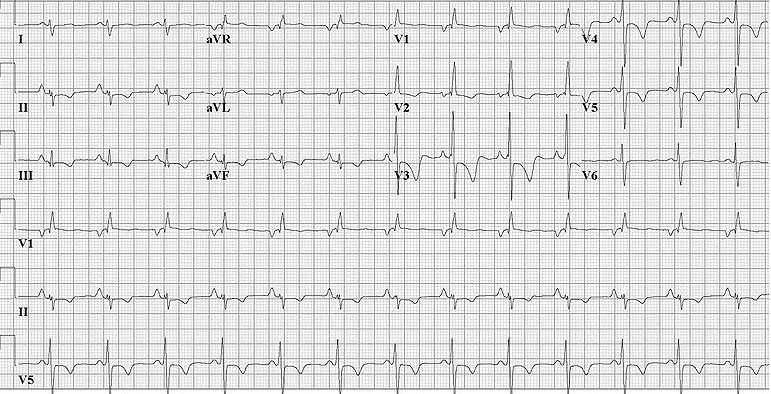Pulmonary hypertension electrocardiogram
|
Pulmonary Hypertension Microchapters |
|
Diagnosis |
|---|
|
Treatment |
|
Case Studies |
|
Pulmonary hypertension electrocardiogram On the Web |
|
American Roentgen Ray Society Images of Pulmonary hypertension electrocardiogram |
|
Risk calculators and risk factors for Pulmonary hypertension electrocardiogram |
Editor(s)-in-Chief: C. Michael Gibson, M.S., M.D. [1]; Assistant Editor(s)-in-Chief: Lisa Prior
Overview
Elevated pulmonary pressures in pulmonary hypertension (PH) can lead to right ventricular hypertrophy (RVH) and right atrial enlargement which can sometimes be observed on an electrocardiogram (ECG). The ECG findings of PH include right axis deviation, right ventricular strain pattern, and P pulmonale. The ECG findings of PH are neither specific nor sensitive and their absence does not rule out the presence of PH.
Electrocardiogram
ECG Findings Suggestive of RVH in Pulmonary Hypertension
- Right axis deviation[1]
- Right atrial enlargement[1]
- Right ventricular hypertrophy[1]
- R/S ratio > 1 in V1
- R wave > 7mm in V1
- rSR' complex in V1 with R' > 10mm
- qR complex in V1
- Right ventricular strain pattern: ST segment and T wave inversion in V1-V3 and occasionally in inferior leads (II, III, AVF)
- Right bundle branch block: QRS duration > 0.12 seconds, rSR' in leads V1 & V2, wide slurred S waves in lateral leads (V5, V6, I)[2]
ECG Findings Suggestive of Right Atrial Enlargement
- P pulmonale: P wave amplitude >2.5mm in inferior leads (II, III, AVF) or >1.5mm in V1/V2
- P wave axis shifted rightward >70°[2]
Use of the Electrocardiogram as a Prognostic Tool
A number of studies have indicated that a qR pattern in V1 and a tall P wave in lead I points to a worse outcome in patients with PH.[3] However up to 13% of patients with significant pulmonary hypertension were shown to have normal ECG findings indicating lack of sensitivity and casting doubt on its use as a prognostic indicator.[4]
EKG Examples
Shown below is an example of right ventricular hypertrophy and right atrial enlargement in a patient with chronic PH. Note P pulmonale that is a P wave amplitude >2.5mm in inferior leads (II, III, AVF) and the T wave inversion in leads II, III, aVF, V2, V3, V4, V5.

References
- ↑ 1.0 1.1 1.2 Poch D, Mandel J (2021). "Pulmonary Hypertension". Ann Intern Med. 174 (4): ITC49–ITC64. doi:10.7326/AITC202104200. PMID 33844574 Check
|pmid=value (help). - ↑ 2.0 2.1 O'Keefe, James (2008). The Complete Guide to ECGS. Jones & Bartlett Pub. ISBN 0-7637-6405-1.
- ↑ Bossone E, Paciocco G, Iarussi D; et al. (2002). "The prognostic role of the ECG in primary pulmonary hypertension". Chest. 121 (2): 513–8. PMID 11834666. Unknown parameter
|month=ignored (help) - ↑ Ahearn GS, Tapson VF, Rebeiz A, Greenfield JC (2002). "Electrocardiography to define clinical status in primary pulmonary hypertension and pulmonary arterial hypertension secondary to collagen vascular disease". Chest. 122 (2): 524–7. PMID 12171826. Unknown parameter
|month=ignored (help)